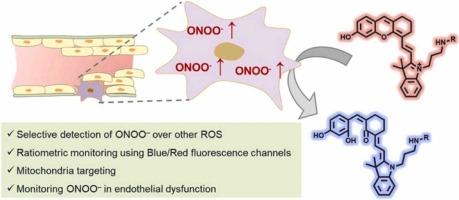活细胞中ONOO -比值荧光团与内皮功能障碍监测
IF 3.7
1区 化学
Q1 CHEMISTRY, ANALYTICAL
引用次数: 0
摘要
过氧亚硝酸盐(ONOO -)由一氧化氮和超氧化物产生,与细胞功能障碍和死亡有关。为了检测活细胞中的ONOO -,我们开发了两种基于半胱氨酸的比例荧光团,P-mito和P-boc。这些比例荧光团成功地用于监测癌细胞和内皮细胞的ONOO -波动。P-mito主要聚集在活细胞的线粒体中,与ONOO -选择性反应后,增加了蓝色通道与红色通道的荧光强度之比。使用ONOO -清除剂n -乙酰半胱氨酸抑制了这一比例的增加。值得注意的是,在用tgf - β2和IL-1β治疗肺动脉内皮细胞诱导的内皮功能障碍模型中,我们的系统成功地证明了ONOO -水平的增加,有效地强调了基于半花青碱的ONOO -荧光反应的效用。因此,我们基于半花青素的ONOO -检测系统为活细胞内ONOO -的时空监测和定量分析提供了一个有效的平台,从而可以在分子水平上研究各种与ONOO相关的病理状况。本文章由计算机程序翻译,如有差异,请以英文原文为准。

Ratiometric fluorophores to ONOO– in living cells and monitoring endothelial dysfunction
Peroxynitrite (ONOO–), generated from nitric oxide and superoxide, is implicated in cellular dysfunction and death. To detect ONOO– in live cells, we developed two hemicyanine-based ratiometric fluorophores, P-mito and P-boc. These ratiometric fluorophores were successfully used to monitor ONOO– fluctuations in cancer cells and endothelial cells. P-mito predominantly accumulated in the mitochondria of live cells and, upon selective reaction with ONOO–, increased the ratio of the fluorescence intensity from blue channel to that from red channel. Treatment with an ONOO– scavenger, N-acetyl cysteine, suppressed this ratio increase. Notably, in a model of endothelial dysfunction induced by treating pulmonary arterial endothelial cells with TGFβ2 and IL-1β, our system successful demonstrated increased ONOO– levels, effectively highlighting the utility of the hemicyanine-based fluorescence response to ONOO–. Therefore, our hemicyanine-based ONOO– detection system provides an effective platform for spatiotemporal monitoring and quantitative analysis of ONOO– within live cells, enabling molecular-level research into various ONOO–-related pathological conditions.
求助全文
通过发布文献求助,成功后即可免费获取论文全文。
去求助
来源期刊

Sensors and Actuators B: Chemical
工程技术-电化学
CiteScore
14.60
自引率
11.90%
发文量
1776
审稿时长
3.2 months
期刊介绍:
Sensors & Actuators, B: Chemical is an international journal focused on the research and development of chemical transducers. It covers chemical sensors and biosensors, chemical actuators, and analytical microsystems. The journal is interdisciplinary, aiming to publish original works showcasing substantial advancements beyond the current state of the art in these fields, with practical applicability to solving meaningful analytical problems. Review articles are accepted by invitation from an Editor of the journal.
 求助内容:
求助内容: 应助结果提醒方式:
应助结果提醒方式:


